Can you Re-Stick LED lights?
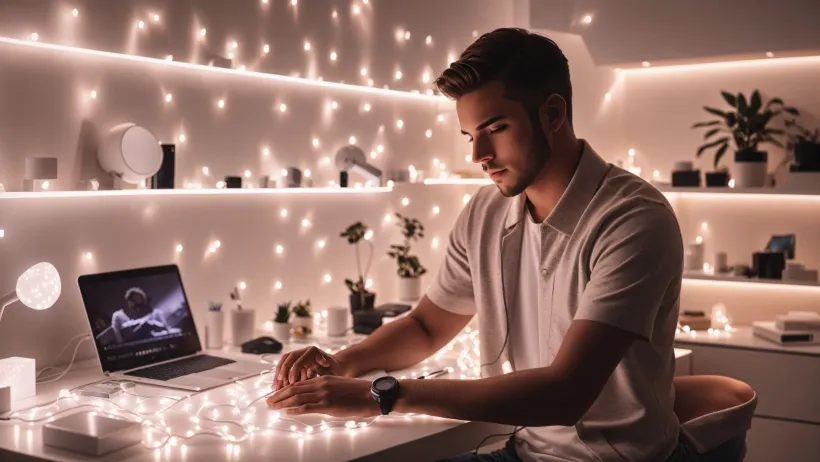
Yes, you can re-stick LED light strips. You can reuse them when moving from one residence to another. You can also re-stick them in your new interior design.
To restick LED light strips, you can:
- Replace the adhesive tape if it no longer adheres to the wall
- Use super glue or any form of strong adhesive.
- Understand that not all adhesive materials will be suitable for this purpose.
- You can also use silicone glue, which has strong heat resistance, low temperature resistance, and is non-toxic.
Ways to Re-Stick LED lights

Before you dive into Ways to Re-Stick LED lights, let’s make sure the surface is spick and span. Get rid of any dust, dirt, or debris – a mild cleaning solution or isopropyl alcohol works wonders. This step ensures a solid and long-lasting adhesion.
Say Goodbye to Old Adhesive
If there are bits of old adhesive clinging on for dear life, it’s time for a clean slate. Gently peel off the old adhesive using your fingers or a plastic scraper. For those stubborn remnants, a citrus-based cleaner or adhesive remover will do the trick, dissolving them away.
Select the Perfect Adhesive
Now, onto the fun part – choosing the right adhesive! There are plenty of options: double-sided adhesive tapes, adhesive clips, glue dots, or Command strips. Just keep in mind the weight of your LED strips and the surface you’re sticking them to when making your choice.
Trim the Adhesive to Size
Measure the length of your LED light strip and give the adhesive a snip to match. Remember, it should be just a smidge shorter than the strip itself to keep things looking neat and tidy.
Application with Precision
Time to get hands-on! Peel off one side of the adhesive backing and gently apply it to the back of your LED light strip. Give it a nice firm press to guarantee a strong bond. Repeat this step along the entire length of the LED strip.
Positioning Perfection
Let’s find that perfect spot for your LED light strip. Gently press it against the surface, starting from one end and working your way along. Remember to keep that pressure even for a secure bond.
Give It Time to Bond
Different adhesives have different bonding times, so let it do its thing. Always follow the Manual instructions for the best results. And, avoid fiddling with or adjusting the LED light strip during this time to keep that bond super strong.
Testing and Tweaking
Once the adhesive has had time to fully bond, give your LED light strip a little test-run to make sure it’s shining bright. If needed, make any adjustments in terms of positioning or alignment.
Considering Extra Support
For those longer LED light strips or spots that need a little extra love, some added support might be just the ticket. You can use extra adhesives or mounting brackets to really secure the LED strip in place.
Maintenance Matters
To keep that adhesion going strong, be mindful of moisture and extreme temperatures. Regularly clean your LED light strips with a soft cloth or sponge dampened with water or a mild cleaning solution.
Remember, these steps are here to guide you. Depending on your specific LED light strip and surface material, there might be a few extra things to consider. Always refer to the manufacturer’s instructions for the nitty-gritty details and safety tips. Happy re-sticking!
What are Some Common Mistakes to Avoid When Resticking LED

Resticking LED light strips can be a tricky process, and there are some common mistakes that you should avoid to ensure optimal performance and longevity of your LED light strips. Here are some of the most common mistakes to avoid:
1. Getting Started with a Clean Slate
Hey there! So, you’re looking to give your LED light strips a new lease on life. Before you dive in, make sure the surface is spick and span. Dust, dirt, and debris won’t do you any favors. A clean surface sets the stage for a solid stick!
2. Picking the Perfect Adhesive
Alright, time to choose the right adhesive buddy. It’s like finding the perfect match for your LED lights and the surface they’ll call home. This choice is key for a strong bond and lights that last.
3. Bid Farewell to Old Adhesive Grime
Got some stubborn old adhesive holding on? No worries! Grab a citrus-based cleaner or adhesive remover and let it work its magic. This step ensures a clean slate for a secure reattachment.
4. Cut with Care
Let’s talk precision when it comes to cutting LED strips. Avoid any impromptu snips, as they could spell trouble for your lighting setup. Stick to those designated cut points for a flawless result.
5. Connectors: Your New BFFs
Time to introduce your LED strips to their new best friends – connectors! Make sure they’re tailor-made for LED strip lights. This ensures a seamless connection that won’t let you down.
6. Mounting Matters
When it comes to mounting, precision is the name of the game. Grab the right adhesive or those nifty mounting brackets designed just for LED strips. Give them a good, secure hold for a long-lasting partnership.
7. Weather Watch
Hey, don’t forget to consider the environment! Moisture and extreme temperatures can be a bit of a downer for your LED strips. Keep them sheltered for a strong and lasting bond.
8. Dim with Delight
Time to set the mood! Pick a dimming and control option that’s best pals with your LED light strips. Compatibility here ensures smooth sailing and no hiccups down the line.
9. Quality is Key
Last but not least, don’t skimp on accessories. Opt for the good stuff to keep your LED light strips shining bright and happy. Quality components make all the difference.
By following these tips, you’ll have your LED light strips dancing with delight for years to come!
How do I Remove Adhesive Residue from my Walls without Damaging Them?

1. Warm Water and Soap Solution
Let’s kick things off with a simple yet powerful mix of warm water and soap. Grab a soft cloth, dip it in the solution, and give that adhesive residue a little rub-down. You’ll see it vanish in no time!
2. Friction Technique
Have some troublesome spots? Begin by removing as much as you can. Then, using a circular motion, apply some elbow grease to it. Those remaining remnants have no chance!
3. Precision Scraping
A small, sharp blade is your secret weapon for those especially sticky places. Scrape away any debris from the friction technique gently. Remember that slow and steady wins the race!
4. Gentle Rubbing with Oil
Time to bring out the big guns – oil! Apply it to the residue and give it a friendly rub. Watch as it loosens up, making it a breeze to wipe away. Your wall will thank you for the spa treatment!
5. Applying Heat for Softening
Feeling a bit stuck? No worries! Grab your trusty heat gun or hairdryer and let them work their magic. Softening that adhesive will make it a cinch to peel off without any harm to your wall. Easy peasy!
6. Sanding Down Residue
If a little residue still wants to hang out, grab some fine-grit sandpaper. Gently give it a once-over, and voila! You’ll have a smooth finish in no time, without any wall casualties.
With these friendly techniques, you’ll bid farewell to pesky adhesive residue without breaking a sweat. Just remember, take it slow and steady, and your walls will be looking brand new in a jiffy! Happy cleaning!
Read More: 5 Easy Steps on how to remove led lights without peeling paint
How to remove LED strip lights from the wall and reuse?
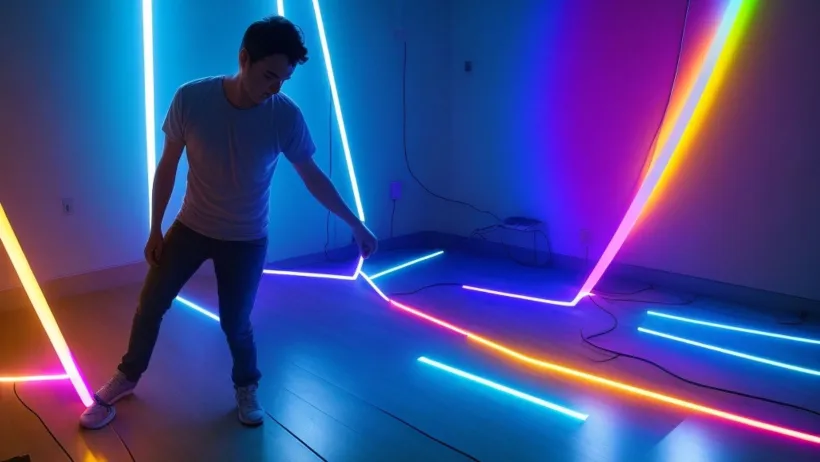
Let’s Get Those LED Strip Lights Moving!
Unplugging and Getting Ready
Hey there, LED enthusiast! First things first, unplug your trusty light strip from its power source. Safety always comes first, right?
Adding a Little Warmth
Alright, it’s time to show that adhesive who’s boss! Grab your hairdryer or heat gun and let it warm gently for about 30-40 seconds. This will make the adhesive nice and pliable.
Peeling Time!
Starting from one end, gently peel the strip away from the wall. Take your time. We want to make sure we don’t stress out the strip.
A Little Nudge, Maybe?
If the strip isn’t quite ready to let go, grab a flat or dull object and gently slide it underneath. A little wiggle might just do the trick!
Farewell, Sticky Residue
You might find a bit of stickiness left on the wall – not a biggie! We’ve got a solution for that.
Let’s Stick It Again!
Before finding a new home for your LED strip, let’s get it all prepped. Apply some fresh adhesive to the backing, making sure it’s spread evenly for a secure fit.
Time for a Reunion!
With adhesive in place, carefully reunite the strip with its new spot. Take your time to align it perfectly for a seamless look.
A Budget-Friendly Option
Considering a new spot for your LED strip lights? Double-sided sticky backing is your wallet’s best friend. It’ll keep things in place without breaking the bank!
Follow these steps and you’ll have those LED strip lights ready to shine in their new spot.
Read More: How to Reuse LED Strips (2 Minutes Step-by-Step Guide)
Conclusion

Re-sticking LED light strips is a simple and effective way to reuse them in new interior designs. To do this, replace the adhesive tape if it no longer adheres to the wall and use super glue or any strong adhesive. Silicone glue is a non-toxic, strong heat and low temperature resistant option. Before re-sticking, ensure the surface is clean and free of dust, dirt, or debris. Remove any old adhesive using a mild cleaning solution or isopropyl alcohol.
FAQ- Can you Re-Stick LED lights
Can I re-stick LED lights?
Yes! You can definitely re-stick LED lights.
How do I re-stick LED strip lights?
1. Peel off the old adhesive using a hair dryer or rubbing alcohol.
2. Wipe the back of the LED strip with a damp cloth.
3. Apply new adhesive like double-sided tape, adhesive dots, or spray adhesive.
4. Press the LED strip firmly onto the surface.
5. Let the adhesive dry before turning on the lights.
What type of adhesive should I use to re-stick LED lights?
The type of adhesive depends on your LED lights and the surface. For smooth surfaces like glass or metal, use double-sided tape or spray adhesive. For rough surfaces like wood or concrete, use a strong adhesive like construction adhesive or epoxy.
How long will re-stuck LED lights last?
The longevity of re-stuck LED lights relies on the adhesive quality and installation conditions. With a good adhesive and indoor, dry conditions, they should last for years.
Are there any tips for re-sticking LED lights?
Ensure the surface is clean and dry.
Apply adhesive evenly.
Press the lights firmly onto the surface.
Let the adhesive dry completely before turning on the lights.



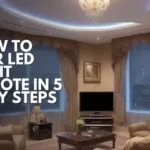



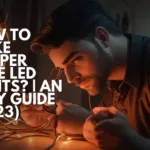

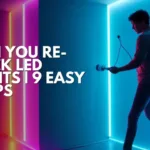

2 thoughts on “Can you Re-Stick LED lights | 9 Easy Steps”